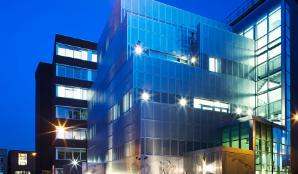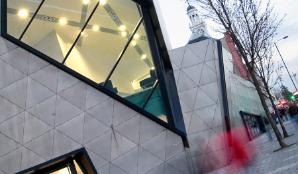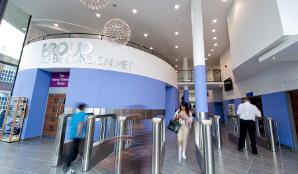
London Metropolitan University is setting out on an aggressive undertaking to understand an energizing future for our understudies and staff.
We are contributing £125m to make another, single grounds in north London – bringing the majority of our resources together on one site without precedent for our 170-year history.
From September 2017, we will begin to move all instructing to Holloway with the point of making one grounds, one group, to empower more noteworthy joint effort and an upgraded understudy experience.
Educator John Raftery, Vice Chancellor of London Met, said: "We are amped up for this venture, which intends to make an one grounds, one group University. We trust this will advantage our understudies, who will appreciate an upgraded understudy experience, and our staff, who will have more chances to team up.
"The general population and organizations of Islington will likewise see advantages to the nearby economy.
"We are currently concentrating on making this energizing future vision a reality."
What do understudies think?
The key driver for this choice was understudy input. An overview with the Students' Union in 2015 found that 65% of understudies, met over every one of the three grounds, said they'd want to study on one grounds.

Obie Opara, President of the SU, said: "From the exploration we completed a year ago, we know numerous understudies would want to study on one grounds, so we respect this choice and the long haul advantages it will bring. We likewise realize this might bring about attentiveness toward a few understudies, especially those at the Aldgate and Moorgate destinations. We will keep on working with understudies over all destinations to guarantee their voice is vital to the improvement of this arrangement, guaranteeing a smooth move and making a more supportable London Met.
"We are energized by the possibility of an one grounds, one group college, where all understudies can cooperate and gain from each other and have admittance to the same offices and the best understudy experience."
At the point when will this happen?
One Campus, One Community is a multi-year venture. Educating will begin to move to Holloway from September 2017 with instructing proceeding at the University's Aldgate and Moorgate destinations in the meantime.
Moving The Cass and Guildhall resources
We are amped up for bringing the majority of our resources together at our new Islington grounds. We are making an energetic and strong University where understudies and staff from all controls can connect and team up; a University where all understudies have the same access to the same amazing offices.
The One Campus, One Community venture will see both our Sir John Cass Faculty of Art, Architecture and Design and our Guildhall Faculty of Business and Law move to Holloway. Generally as at Aldgate, individuals from The Cass are welcome to assume a key part in molding their new learning environment.
Another educational programs
The University is finishing an audit of our educational programs to guarantee we are just offering prevalent courses which prompt fantastic results for our understudies. We are to a great degree glad for our quality expressions, business and law courses, and they will have a home at Holloway.

Discussion
A noteworthy discussion period starts on 11 January and will keep running until April. It is essential that understudies, staff and every single intrigued partie get invovled and share their thoughts regarding the future grounds. Visit the Create your Campus page to join in.
post this page to facebook
tweet this page
bookmark
email this page to a companion
print this page
FAQs
The One Campus, One Community venture, which will see us contribute £125m to make another grounds for every one of our resources in Islington, speaks to a period of energizing change for London Met. Times of progress, notwithstanding, can bring about instability, so we have recognized various regular inquiries regarding the venture that understudies, staff and individuals from the general population might want replying.
In the event that you'd like more inquiries replied, please send them to communications@londonmet.ac.uk, and we'll do the rest.
What persuaded the choice, and were understudies counseled some time recently?
London Met is a considerable measure littler, regarding understudy numbers, than it used to be. In light of the current year's enrolment, London Met now scales up to a University of around 10,000 understudies, yet the grounds we have used to bolster 25,000 understudies. There are right now 40,000 square meters of abundance space at the University, which understudies' expenses are paying for. We need to address this.
Moving every one of our resources to Holloway will make an a great deal more effective grounds and empower us to put £125m in new offices, including bespoke workshops and studio spaces for The Cass and another Bloomberg suite for Guildhall Faculty of Business and Law.

The offices for understudies officially based at Holloway will likewise be moved forward.
As a feature of the University's Strategic Plan examine prior this year, more than 400 understudies were studied by the Students' Union about their involvement with London Met, and how it can enhance in future. This incorporated an inquiry on whether understudies would like to study on a present day, single grounds, and the dominant part of understudies overviewed upheld this thought. This included understudies from every one of the four resources, and the outcomes were weighted to mirror the quantity of London Met understudies in every workforce.
What choices were considered?
The University took a gander at an extensive variety of alternatives to attempt and distinguish the best one which would address our littler size, overabundance space and the need to enhance offices for understudies. This included taking a gander at moving all resources to Aldgate grounds, however this was not a feasible alternative. Just Holloway grounds has the space and adaptability to bring the majority of our understudies, resources and staff together on an advanced, single grounds in which we are contributing £125m.
Where is the £125m originating from?
The One Campus, One Community venture is chiefly financed by the offer of structures that we will no more require at Aldgate. Business Road, which houses part of The Cass, was sold in 2015 to the Department for Education. Focal House, which houses the other part of The Cass, is at present available to be purchased. Both structures have a "lease back" provision into the business, which means we can keep them for the period we require them for.
The offers of these structures arranges for the cash required to put resources into new offices at Holloway, including new bespoke studio spaces and workshops for Cass understudies. We promise that these offices will be of a higher standard than those as of now at Aldgate.
Is it accurate to say that you are auctioning Central House to pay off obligation?
By no means. A few individuals have said this and it's even wound up in the media, yet it is not genuine. The cash raised from the offer of Central House will be specifically put resources into the One Campus venture.
Is it accurate to say that you are shutting the Sir John Cass Faculty of Art, Architecture and Design?
No! We are contributing £125m to make another home for The Cass in Islington. A few individuals are troubled about moving the workforce from Aldgate to Islington, and have asserted we are "shutting" or notwithstanding "executing" The Cass, yet this is not genuine. The Cass is moving, not shutting. Fresh out of the plastic new workshops and studio spaces will be made in Holloway to guarantee The Cass' ethos of making proceeds. The move will likewise unite The Cass in one area, rather than its present split between Central House and Commercial Road. Our exceedingly fruitful architecure division depended on Holloway Road since 1897 preceding converging with our specialty and plan office in Aldgate to make The Cass three years back. We feel another move, with significantly more speculation, must be sure. This venture speaks to a multi-million pound interest in expressions training.
What inclusion will understudies have in the improvement and arranging process?
Ideally, parcels! We told staff and understudies about the choice the morning after it had been made by the University's Board of Governors. We did this since we needed to tell them at the earliest opportunity and to welcome them to work with us on building up the arrangements. This is the motivation behind why we have been not able offer solid arranges yet - they aren't there yet on the grounds that we need staff and understudies to make them with us.
We need their thoughts and sees on what they need to see at our new single grounds, and we will be propelling a staff and understudy counsel process in January.
We are likewise delegating a "Masterplanner" who will be in charge of outlining and constructing the new offices. As a feature of the procedure for selecting the Masterplanner, we made it clear that they will need to work intimately with understudies to ensure you get the offices they require. You can read about the Masterplanner choice here.
Understudies' Union delegates likewise meet frequently with the Vice Chancellor and individuals from the Senior Leadership Team to guarantee understudies' voices are being listened.
By what method will the University create and deal with the space at Holloway to abstain from congestion?
London Met at present has 40,000 square meters of abundance space and a littler understudy body. Before, Holloway grounds was home to numerous a larger number of understudies than we have today. A lot of space at Holloway isn't utilized to its potential and there are a lot of the day where space goes unused. A portion of the £125m speculation will be spent reconfiguring the grounds to guarantee there is sufficient enhanced instructing space, social space and offices at Holloway to suit everybody.
There is no peril at all of Holloway grounds not having the capacity to serenely house an understudy assortment of 10,000 understudies, as this is in line, space astute, with different colleges.
Space won't be an issue on the new grounds.
What offices will be accessible and how is the University going to deliver access to offices particularly the library and IT?
All understudies will have admittance to the offices and administrations they require at Holloway. Besides, we are ensuring that offices will be superior to those right now delighted in as of now.
HISTORY
London Met's long, rich history begins in 1848 when the Bishop of London and the Reverend Charles Mackenzie set up The Metropolitan Evening Classes for Young Men.
1848 The classes are set up as an aftereffect of the Bishop's speak to his church "to enhance the scholarly and good states of the modern classes".
1851 Prince Albert is so inspired with the classes that a yearly festival of the understudies' work is held under his support. Regal support has proceeded, and today the supporter of London Met is HRH Prince Philip.
1861 Enrolment numbers expansion to 800 and the classes are built up as the City of London College. The next year all instructors are paid interestingly and an essential is named.
1896 The Northern Polytechnic Institution in Holloway opens its entryways. Its main goal: 'To advance the mechanical aptitude, general information, wellbeing and wellbeing of young fellows and ladies'.
A thousand understudies select in the first year to be taught by 34 individuals from staff on courses including English, Chemistry, Botany, Hygiene, and Elocution. All were at basic level and most were offered as night classes.
1899 Sir John Cass Technical Institute is established by Sir John Cass (1661-1718), an Alderman of the Ward of Portsoken, a region in which the University's Jewry Street assembling now stands. The income from the beneficent trust he supplied empowered the governors of the Sir John Cass Foundation to build up initial a school, and later the Technical Institute. Courses included material science, hypothetical mechanics and household economy (which included dressmaking, cookery and housewifery).
1900 The Northern Polytechnic is a moment achievement; understudy numbers had multiplied and, by 1910, each division offered day classes. Somewhat later, five-year evening degrees were accessible, as was exploration supervision on Saturdays.
1902 King Edward VII Nautical College established.
1927 The branch of route built up at the Sir John Cass Technical Institute to give full-time courses in route.
1929 The North Western Polytechnic set up and enlists more than 2,200 understudies with a scholastic staff of 150. The Polytechnic focuses on sociologies, humanities and expressions. Its site in Kentish Town is opened by HRH Edward, Prince of Wales, and silver screen gatherings of people all through the nation watch the occasion on Pathe News.
1940 The City of London College bombing so as to build is totally decimated.
1944 700 understudies select on courses in the first term of the City of London College's new home at Electra House, Moorgate.
1949 The division of route's more junior courses are exchanged to the King Edward VII School under the London County Council advancement arrangement. The route division of Poplar Technical College shut and its courses exchanged to the Sir John Cass College Technical Institute.
1950 Sir John Cass Technical Institute changes its name to Sir John Cass College.
1954 The Sir John Cass preparing vessel, a 112-foot engine dispatch is changed over into a coasting school to empower understudies to ponder the operation of radar hardware and other advanced navigational guides. It turns into a normal sight on the River Thames.
1960 The aggregate understudy move of the City of London College is more than 8,000.
1961 The tercentenary of the conception of Sir John Cass.
1964 Shoreditch Technical Institute renamed London College of Furniture.
1965 Sir John Cass School of Art established by the amalgamation of the division of silversmithing and united artworks from the Central School of Art, and the bureau of fine and connected craftsmanship from the Sir John Cass College. The new school takes up living arrangement in Central House, inverse the Whitechapel Art Gallery.
1966 White Paper distributed, 'A Plan for Polytechnics' - "to give the method for growing advanced education ... by offering courses which are important to the professional points of understudies and in the meantime hold the adaptability which will empower these establishments to react to quickly evolving requests".
1967 Constituent schools of polytechnic proposition and ILEA hold initially meeting to consider the arrangement of new polytechnics.
1969 School of Navigation shaped by the amalgamation of the senior division of the King Edward VII Nautical College and route bureau of Sir John Cass College.
1970 The Sir John Cass College turns into the Sir John Cass School of Science and Technology and the City of London College turns into the School of Business on their joining into City of London Polytechnic.
1971 Reception held at Guildhall to check the event of the assignment of the new City of London Polytechnic, which begins with 2,000 full-time and 15,000 low maintenance understudies.
1971 The Northern and North Western polytechnics converge to shape the Polytechnic of North London.
1990 London College of Furniture joins the City of London Polytechnic.
1992 Further and Higher Education Act gets Royal Assent, which gives polytechnics college status and degree recompensing powers. City of London Polytechnic's new name is London Guildhall University. The Polytechnic of North London turns into the University of North London.
1996 University of North London praises its centennial.
1998 London Guildhall University praises its 150th commemoration.
2002 London Guildhall University converges with the University of North London on 1 August to frame London Metropolitan University. This is the first merger between two colleges in the UK.
2003 A function is held at Mansion House in the City of London, went to by the Patron, to dispatch the University. The Duke of Edinburgh, the then Patron, is recompensed London Metropolitan University's first degree.
2003 Launch functions held in Brussels, China, Cyprus, Greece, India and Pakistan.
2004 Two new structures opened: the Graduate School, planned by Daniel Libeskind, and the Goulston Street building, intended for the educating of law courses. Work starts on the science square.
2006 New Science Center opens containing the biggest and most developed science showing office in Europe. It incorporates a Super Lab with 280 individual workstations and a universal quality ball court produced using reused flying machine tires.
2007 Launch of London Metropolitan Business School, one of Europe's biggest business colleges and the biggest instruction supplier of expert courses in the UK's South East.
2008 London Met turns into a London 2012 Pre-Games preparing office. His Holiness the fourteenth Dalai Lama is granted an Honorary Doctorate in Philosophy.
2009 66% of the exploration yields presented by the University to the Research Assessment Exercise are judged to be 'universally perceived', 'globally fabulous' or world-driving'.
2010 On 25 January Professor Malcolm Gillies joins London Met as the new Vice-Chancellor and Chief Executive. With his administration group he makes the Strategic Plan 2010-2013: Transforming lives, addressing needs and fabricating professions.
2011 London Metropolitan University gets the most elevated honor in the Quality Assurance Agency (QAA) survey distributed on 15 April 2011.
2013 HRH The Duke of York, KG succeeds his dad, The Duke of Edinburgh, as Patron of London Metropolitan University.
EmoticonEmoticon